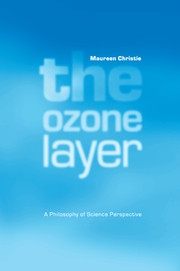Book contents
- Frontmatter
- Contents
- List of figures
- List of abbreviations
- Preface
- 1 Introduction
- Part I History of the understanding of stratospheric ozone
- 2 Stratospheric ozone before 1960
- 3 Chlorinated fluorocarbons
- 4 The Supersonic Transport (SST) debate
- 5 Molina and Rowland: chlorine enters the story
- 6 Too much of a good thing? Crucial data backlog in the Antarctic ozone hole discovery
- 7 Antarctic ozone hole – theories and investigations
- 8 Completing the picture: from AAOE to 1994
- Part II Philosophical issues arising from the history
- References
- Index
7 - Antarctic ozone hole – theories and investigations
Published online by Cambridge University Press: 22 September 2009
- Frontmatter
- Contents
- List of figures
- List of abbreviations
- Preface
- 1 Introduction
- Part I History of the understanding of stratospheric ozone
- 2 Stratospheric ozone before 1960
- 3 Chlorinated fluorocarbons
- 4 The Supersonic Transport (SST) debate
- 5 Molina and Rowland: chlorine enters the story
- 6 Too much of a good thing? Crucial data backlog in the Antarctic ozone hole discovery
- 7 Antarctic ozone hole – theories and investigations
- 8 Completing the picture: from AAOE to 1994
- Part II Philosophical issues arising from the history
- References
- Index
Summary
At the time of its discovery, the springtime Antarctic ozone depletion was an unexpected phenomenon that had no obvious explanation. A new problem had been set for theoretical science: the task of finding an explanation that fitted with the observational evidence, and that could be integrated into the body of what was already known about ozone and the stratosphere. Rapidly, a number of speculative hypotheses were put forward.
In the paper announcing the original discovery (Farman et al., 1985), the effect was attributed to rising levels of inert chlorine compounds in the atmosphere. This in turn was linked to the widespread and increasing production and use of CFCs. The authors pointed to a correlation between CFC mixing ratios in the atmosphere at ground level, and Antarctic ozone levels in the stratosphere, both in spring and in autumn.
But models of stratospheric chemistry had always shown that any chlorine-mediated ozone depletion would be most significant at high altitudes in the tropical stratosphere. An Antarctic anomaly could not be produced within the normal framework of reactions used for stratospheric chlorine/ozone chemistry. It was clear that any attempt to explain the phenomenon would need to be based on the inclusion of some new chemical reactions in the system.
- Type
- Chapter
- Information
- The Ozone LayerA Philosophy of Science Perspective, pp. 53 - 65Publisher: Cambridge University PressPrint publication year: 2001



